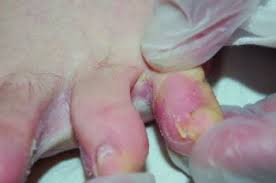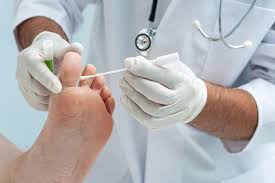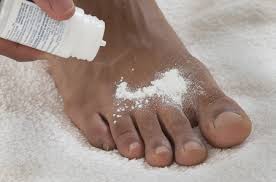Athlete’s Foot Treatment Options: OVER THE COUNTER and Prescription Remedies
Athlete’s foot, also known as tinea pedis or ringworm of the feet is a common fungal infection affecting the skin on the feet. It’s caused by dermatophytes, thriving in warm, moist environments. Symptoms include dry, scaly patches, red rash, itching, and blisters. It’s highly contagious and can spread through direct contact or sharing contaminated items. Please keep reading for details on the following:
Causes of Athlete’s Foot
Symptoms of Athlete’s Foot
Diagnosis of Athlete’s Foot
Prevention of Athlete’s Foot
Treatment of Athlete’s Foot
Complications of Athlete’s Foot

Causes of Athlete’s Foot
Athlete’s foot is caused by a group of fungi called dermatophytes. These fungi thrive in warm and moist environments such as locker rooms, swimming pools, and communal showers. They can also be found in damp shoes and socks. When the feet are exposed to these fungi, they can easily become infected. Athlete’s foot is highly contagious and can spread from person to person through direct contact or by sharing contaminated items such as towels, socks, and shoes.
Signs and symptoms of Athlete’s Foot
Prevention of Athlete’s Foot
- Use antifungal powders or sprays on the feet and in shoes to reduce fungal growth.
- Avoid sharing towels, socks, and shoes with others to minimize the risk of spreading the infection.
- Keep feet clean and dry by washing and thoroughly drying them daily, paying special attention to the spaces between toes.
- Opt for breathable shoes and socks made of natural materials to allow air circulation and reduce moisture buildup.
- Avoid wearing rubber or plastic shoes for prolonged periods as they retain moisture.
- Change socks and shoes frequently, especially after sweating or getting them wet.
- Allow shoes to dry completely before wearing them again.
- Avoid walking barefoot in public areas, especially in places like locker rooms, showers, and swimming pools.
- Use antiperspirant spray on the feet to help control excessive sweating, which can create a favorable environment for fungal growth.
-
If prone to sweaty feet, consider using moisture-wicking socks and rotating shoes to allow them to dry thoroughly between uses.
Diagnosis of Athlete’s Foot

Athlete’s foot can usually be diagnosed by a healthcare provider based on the appearance of the affected skin. In some cases, a skin scraping may be taken to confirm the presence of fungi. If the infection is severe or does not respond to treatment, a biopsy may be necessary to rule out other conditions.
Treatment of Athlete’s Foot
Natural remedies for athlete’s foot

- Keeping feet dry: Moisture encourages fungal growth, so keeping the feet clean and dry is essential. Change socks regularly and ensure shoes are well-ventilated.
- Foot powder: Applying antifungal foot powders or cornstarch can help absorb moisture and inhibit fungal growth.
- Garlic: Garlic has antifungal properties. You can make a paste of mashed garlic and oil and apply it to the affected area, sprinkle garlic powder on the area, or insert pieces of garlic into shoes.
- Sunlight exposure: Direct sunlight can help kill fungi. Placing shoes in direct sunlight or exposing bare feet to sunlight for short periods may be beneficial.
- Tea tree oil: Tea tree oil has natural antifungal properties. You can apply a few drops of tea tree oil to an aromatic foot bath containing vinegar and then apply it to the affected area or soak the feet in a warm foot bath containing tea tree oil, sage oil, and peppermint oil.
- Epsom salt: Soaking the feet in warm water with Epsom salt for 15 minutes several times a day can help relieve symptoms and inhibit fungal growth.
- Rubbing alcohol: Dabbing the affected area with rubbing alcohol can help dry out the rash and inhibit fungal growth.
- Vinegar: Soaking the feet in a solution of vinegar and water (1 part vinegar to 10 parts water) may help control fungal growth due to vinegar’s acidic properties.
- Tea bags: Soaking the feet in warm water containing tea bags for 10 minutes can help relieve itching and inflammation.
- Proper foot hygiene: Regularly washing and drying the feet, avoiding sharing towels and personal items, and wearing breathable shoes and socks can help prevent and manage athlete’s foot naturally.
Complications of Athlete’s Foot
- Spread to other body parts such as the groin and hands.
- Scratching the affected areas can lead to breaks in the skin, increasing the risk of secondary bacterial infections. These infections can cause more serious health problems and may require additional treatment.
- Toenails can become thickened, discolored, and brittle, a condition known as onychomycosis.
When to Seek urgent medical care
You should seek urgent medical care for athlete’s foot if:
- The condition persists for more than one week despite over-the-counter treatments.
- Toenails become infected or show signs of severe fungal involvement.
- You have diabetes, as foot infections can lead to serious complications in individuals with diabetes.
- You have a weakened immune system due to conditions such as HIV/AIDS, undergoing chemotherapy, or taking immunosuppressants.
- If the affected area shows signs of spreading or worsening infection, such as increased redness, swelling, pain, or drainage.
- If you experience severe symptoms or complications such as fever, difficulty walking, or allergic reactions.
Disclaimer: The information provided in this content is for general informational purposes only. It is not intended as medical or healthcare advice, diagnosis, or treatment. Always seek the advice of a qualified healthcare professional with any questions you may have regarding a medical condition or healthcare decisions.

